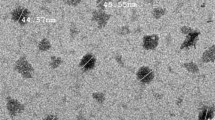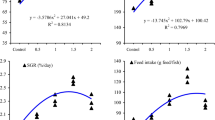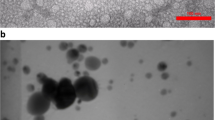Abstract
The present study describes, for the first time, the protective effect of natural curcumin in vivo in a lower vertebrate, a teleost, Anabas testudineus (Bloch). Two doses of curcumin 0.5 and 1% were supplemented in the 40% protein feed and fed to fish for the periods, 2 and 8 weeks. The antioxidant status, protein content, and the tissue structure in experimental fish were examined after the short-term and long-term feeding. In all the curcumin fed groups, the lipid peroxidation product, thiobarbituric acid reactive substances content either decreased or unaffected. The glutathione content increased while the antioxidant enzyme activity pattern varied with time and dose. The histological analysis also confirmed the safety of curcumin retaining the normal arrangement of hepatocytes, hepatopancreas, macrophage–melanocyte centers in Anabas. The improved antioxidant status and protein content suggest a favorable effect for curcumin in cultured fish.




Similar content being viewed by others
References
Ahuja KD, Kunde DA, Ball MJ, Geraghty DP (2006) Effects of capsaicin, dihydrocapsaicin, and curcumin on copper-induced oxidation of human serum lipids. J Agric Food Chem 54:6436–6439
Allen PC, Danforth HD, Augustine PC (1998) Dietary modulation of avian coccidiosis. Int J Parasitol 28:1131–1140
AL-Sultan SI (2003) The effect of Curcuma longa (turmeric) on overall performance of broiler chickens. Int J Poult Sci 5:351–353
Ambegaokar SS, Wu L, Alamshahi K, Lau J, Jazayeri L, Chan S, Khanna P, Hsieh E, Timiras PS (2003) Curcumin inhibits dose-dependently and time dependently neuroglial cell proliferation and growth. Neuro Endocrinol Lett 24:469–473
Antunes LMG, Dias FL, Takahashi CS (1999) Potentiation by turmeric and curcumin of radiation induced chromosome aberration in Chinese hamster ovary cells. Teratogen Carcin Mut 19:9–18
Apisariyakul A, Vanittanakom N, Buddhasukh D (1995) Antifungal activity of turmeric oil extracted from Curcuma longa (Zingiberaceae). J Ethnopharmacol 49(3):163–169
Araujo MC, Dias FL, Kronka SN, Takahashi CS (1999a) Effect of turmeric and its active principle, curcumin on bleomycin induced chromosome aberrations in Chinese hamster ovary cells. Genet Mol Biol 22:407–413
Araujo MC, Dias FL, Takahashi CS (1999b) Potentiation of turmeric and curcumin of γ-radiation induced chromosome aberrations in Chinese hamster ovary cells. Teratogenesis Carcinog Mutagen 19:9–18
Bandyopadhyay U, Das D, Banerjee RK (1999) Reactive oxygen species: oxidative damage and pathogenesis. Curr Sci 77:658–666
Beauchamp C, Fridovich I (1971) Superoxide dismutase: improved assays and an assay applicable to acrylamide gels. Anal Biochem 44:276–278
Benke GM, Cheevar KC (1974) Comparative toxicity, anti-cholinesterase action and metabolism of methyl parathion and parathion in sun fish and mice. Toxicol Appl Pharmacol 28:97–109
Bernet D, Schmidt H, Meier W, Burkhardt-Holm P, Wahli T (1999) Histopathology in fish: proposal for a protocol to assess aquatic pollution. J fish diseases 22:25–34
Bhavanishankar TN, Shanta NV, Ramesh HP, Murthy Indira AS, Sreenivasmurthy V (1980) Toxicity studies on turmeric (Curcuma longa): Acute toxicity studies in rats, guinea pigs and monkeys. Ind J Exp Biol 18:73–75
Bille N, Larsen JC, Hansen EV, Wurtzen G (1985) Subchronic oral toxicity of turmeric oleoresin in pigs. Food Chem Toxicol 23:967–973
Bradford MM (1976) A rapid and sensitive method for the quantitation of microgram quantities of protein utilizing the principle of protein-dye-binding. Anal Biochem 72:248–254
Clark G (ed) (1981) Staining procedures used by the Biological Stains Commission In: Staining procedures, 4th edn. Williams and Wilkins, Baltimore, pp 471–472
D’Souza HP, Prabhu HR (2006) In vitro inhibition of lipid peroxidation in fish by turmeric (Curcuma longa). Indian J Clin Biochem 21(2):138–141
David M, Richard JS (1983) Glutathione reductase. Method Enzymol Anal 3:258–265
Deshpande UR, Gadre SG, Raste AS, Pillai D, Bhide SV, Samuel AM (1998) Protective effect of turmeric (Curcuma longa L.) extract on carbon tetrachloride induced liver damage in rats. Ind Exp Biol 36:573–577
Duncan DB (1955) Multiple range and multiple F test. Biometrics 11:1–42
Elizabeth K, Rao MNA (1990) Oxygen radical scavenging activity of curcumin. Int J Pharm 58:237–240
Eshrat H, Ali Hussain M (2002) Hypoglycemic, hypolipidemic and antioxidant properties of combination of curcumin from Curcuma longa, linn, and partially purified product from Abroma augusta, linn. in streptozotocin induced diabetes. Indian J Clin Biochem 17(2):33–43
Gabriel O (1971) Analytical disc gel electrophoresis. Methods Enzymol 22:565–578
Halliwell B, Gutteridge JMC (1990) Role of free radicals and catalytic metal ions in human disease: an overview. Methods Enzymol 186:59–85
Hardy R (1980) Fish feed formulation. Lectures presented at the FAO/UNDP Training course in fish feed technology, held at the College of Fisheries. University of Washington, Seattle, pp 233–240
Johnson C (2004) Influence of certain plant extract on growth and metabolism of teleosts (Anabas testudineus and Labeo rohita) and a mammal (Rattus norvegicus). Ph.D thesis, University of Kerala, Thiruvananthapuram, Kerala, India
Kakkar P, Das B, Viswanathan PN (1984) A modified spectrophotometric assay of superoxide dismutase. Indian J Biochem Biophys 21:130–132
Kamalakkannan N, Rajagopalan R, Suresh PV, Viswanathan P, Rajasekharan KN, Menon VP (2005) Comparative Effects of curcumin and an analogue of curcumin in carbon tetrachloride-induced hepatotoxicity in rats. Basic Clin Pharmacol Toxicol 97(1):15–21
Kandarkar SV, Sharda SS, Ingle AD, Deshpande SS, Maru GB (1998) Subchronic oral hepatotoxicity of turmeric in mice—histopathological and ultrastructural studies. Ind J Exp Biol 36:675–679
Kato K, Ito H, Kamei K, Iwamoto I (1998) Stimulation of the stress-induced expression of stress proteins by curcumin in cultured cells and in rat tissues in vivo. Cell Stress Chap 3:152–160
Kelloff GJ, Crowell JA, Steele VE, Lubet RA, Malone WA, Boone CW et al (2000) Progress in cancer chemoprevention: development of diet-derived chemopreventive agents. J Nutr 130:467S–471S
Kelly MR, Xu J, Alexander KE, Loo G (2001) Disparate effects of similar phenolic phytochemicals as inhibitors of oxidative damage to cellular DNA. Mut Res 485:309–318
Lawrence RA, Burk RF (1976) Glutathione peroxidase activity in selenium-deficient rat liver. Biochem Biophys Res Commun 71:952–958
Livingstone DR (2001) Contaminant stimulated reactive oxygen production and oxidative damage in aquatic organisms. Mar Pollut Bull 42:656–666
Livingstone DR (2003) Oxidative stress in aquatic organisms in relation to pollution and aquaculture. Rev Med Vet 154:427–430
Maehly A, Chance B (1954) The assay of catalases and peroxidases. Methods Biochem Anal 1:357–424
Manju M, Sherin TG, Rajeesha KN, Sreejith P, Rajasekharan KN, Oommen OV (2008a) Curcumin and its derivatives prevent hepatocyte lipid peroxidation in Anabas testudineus. J Fish Biol 73:1701–1713
Manju M, sherin TG, Rajasekharan KN, Oommen OV (2008b) Curcumin analogue inhibits lipid peroxidation in a freshwater teleost, Anabas testudineus (Bloch)—an in vitro and in vivo study. Fish Physiol Biochem. doi:10.1007/s10695-008-9266-6
Mishra HP, Fridovich I (1977) Superoxide dismutase and peroxidase; a positive activity staining applicable to poly acrylamide gel electrophorograms. Arch Biochem Bio phys 183:511–515
Motterlini R, Foresti R, Bassi R, Green CJ (2000) Curcumin, an antioxidant and anti-inflammatory agent induces heme oxygenase-1 and protects endothelial cells against oxidative stress. Free Radic Biol Med 28:1303–1312
Nichans WG, Samuelsson B (1968) Formation of malondialdehyde from phospholipid arachidonate during microsomal lipid peroxidation. Eur J Biochem 6:126–130
Park EJ, Jeon CH, Ko G, Kim J, Sohn DH (2000) Protective effect of curcumin in rat liver injury induced by carbon tetrachloride. J Pharm Pharmacol 52:437–440
Pulla Reddy AC, Lokesh BR (1992) Studies on spice principles as antioxidants in the inhibition of lipid peroxidation of rat liver microsomes. Mol Cell Biochem 111:117–124
Ramý′rez-Tortosa MC, Mesa MD, Aguilera MC, Quiles JL, Baro′ L, Ramirez-Tortosa CL et al (1999) Oral administration of a turmeric extract inhibits LDL oxidation and has hypocholesterolemic effects in rabbits with experimental atherosclerosis. Atherosclerosis 147:371–378
Rasmussen HB, Christensen SB, Kvist LP, Karazmi A (2000) A simple and efficient separation of the curcumins, the antiprotozoal constituents of Curcuma longa. Planta Med 66:396–398
Rinaldi AL, Morse MA, Fields HW, Rothas DA, Pei P, Rodrigo KA, Renner RJ, Mallery SR (2002) Curcumin activates the aryl hydrocarbon receptor yet significantly inhibits (−)-Benzo(a)pyrene-7R-trans-7,8-dihydrodiol bioactivation in oral squamous cell carcinoma cells and oral mucosa. Cancer Res 62:5451–5456
Ruby JA, Kuttan G, Dinesh Babu KV, Rajasekharan KN, Kuttan R (1995) Anti-tumour and free radical scavenging activity of synthetic curcuminoids. Int J Pharm 131:1–7
Ruby JA, Kuttan G, Dinesh Babu KV, Rajasekharan KN, Kuttan R (1998) Anti-inflammatory activity of natural and synthetic curcuminoids. Pharm Pharmacol Commun 4:103–106
Soudamini KK, Kuttan R (1989) Inhibition of chemical carcinogenesis by curcumin. J Ethnopharmacol 27:227–233
Sun Y, Elwell JH, Oberley LW (1988) A simultaneous visualization of the antioxidant enzymes glutathione peroxidase and catalase on polyacrylamide gels. Free Radic Res Commun 5:67–75
Swarnakar S, Ganguly K, Kundu P, Banerjee A, Maity P, Sharma AV (2005) Curcumin regulates expression and activity of matrix metalloproteinase 9 and 2 during prevention and healing of indomethacin-induced gastric ulcer. J Biol Chem 280:9409–9415
Urbina-Cano P, Morales BL, Herrera MA, Rivera JR, Magna ML, Sanroman R, Rivera A (2006) DNA damage in mouse lymphocytes exposed to curcumin and copper. J Appl Genet 47:377–382
Wahlstrom B, Blennow G (1978) A study on the fate of curcumin in the rat. Acta Pharmcol Toxicol 43:86–92
Weston DP (1996) Ecological effects of the use of chemicals in aquaculture. In: Use of chemicals in aquaculture in Asia. Arthur JR, Lavilla-Pitogo CR, Subasinghe RP (eds) Proceedings of the Meeting on the Use of chemicals in aquaculture in Asia 20–22 May 1996. Tigbauan, Iloilo, Philippines
Acknowledgments
The authors are grateful to the Council of Scientific and Industrial Research (CSIR), New Delhi for providing the Senior Research Fellowship (M.M) and University Grants Commission–Special Assistance Programme (UGC-SAP) for the infrastructural facilities.
Author information
Authors and Affiliations
Corresponding author
Rights and permissions
About this article
Cite this article
Manju, M., Akbarsha, M.A. & Oommen, O.V. In vivo protective effect of dietary curcumin in fish Anabas testudineus (Bloch). Fish Physiol Biochem 38, 309–318 (2012). https://doi.org/10.1007/s10695-011-9508-x
Received:
Accepted:
Published:
Issue Date:
DOI: https://doi.org/10.1007/s10695-011-9508-x




